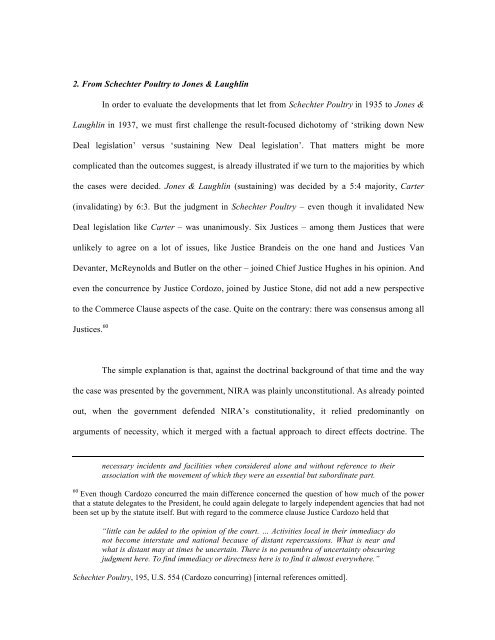Jasper Finke, Crisis and Law - New York University School of Law
Jasper Finke, Crisis and Law - New York University School of Law
Jasper Finke, Crisis and Law - New York University School of Law
You also want an ePaper? Increase the reach of your titles
YUMPU automatically turns print PDFs into web optimized ePapers that Google loves.
2. From Schechter Poultry to Jones & Laughlin<br />
In order to evaluate the developments that let from Schechter Poultry in 1935 to Jones &<br />
Laughlin in 1937, we must first challenge the result-focused dichotomy <strong>of</strong> ‘striking down <strong>New</strong><br />
Deal legislation’ versus ‘sustaining <strong>New</strong> Deal legislation’. That matters might be more<br />
complicated than the outcomes suggest, is already illustrated if we turn to the majorities by which<br />
the cases were decided. Jones & Laughlin (sustaining) was decided by a 5:4 majority, Carter<br />
(invalidating) by 6:3. But the judgment in Schechter Poultry – even though it invalidated <strong>New</strong><br />
Deal legislation like Carter – was unanimously. Six Justices – among them Justices that were<br />
unlikely to agree on a lot <strong>of</strong> issues, like Justice Br<strong>and</strong>eis on the one h<strong>and</strong> <strong>and</strong> Justices Van<br />
Devanter, McReynolds <strong>and</strong> Butler on the other – joined Chief Justice Hughes in his opinion. And<br />
even the concurrence by Justice Cordozo, joined by Justice Stone, did not add a new perspective<br />
to the Commerce Clause aspects <strong>of</strong> the case. Quite on the contrary: there was consensus among all<br />
Justices. 60<br />
The simple explanation is that, against the doctrinal background <strong>of</strong> that time <strong>and</strong> the way<br />
the case was presented by the government, NIRA was plainly unconstitutional. As already pointed<br />
out, when the government defended NIRA’s constitutionality, it relied predominantly on<br />
arguments <strong>of</strong> necessity, which it merged with a factual approach to direct effects doctrine. The<br />
necessary incidents <strong>and</strong> facilities when considered alone <strong>and</strong> without reference to their<br />
association with the movement <strong>of</strong> which they were an essential but subordinate part.<br />
60 Even though Cardozo concurred the main difference concerned the question <strong>of</strong> how much <strong>of</strong> the power<br />
that a statute delegates to the President, he could again delegate to largely independent agencies that had not<br />
been set up by the statute itself. But with regard to the commerce clause Justice Cardozo held that<br />
“little can be added to the opinion <strong>of</strong> the court. … Activities local in their immediacy do<br />
not become interstate <strong>and</strong> national because <strong>of</strong> distant repercussions. What is near <strong>and</strong><br />
what is distant may at times be uncertain. There is no penumbra <strong>of</strong> uncertainty obscuring<br />
judgment here. To find immediacy or directness here is to find it almost everywhere.”<br />
Schechter Poultry, 195, U.S. 554 (Cardozo concurring) [internal references omitted].
















